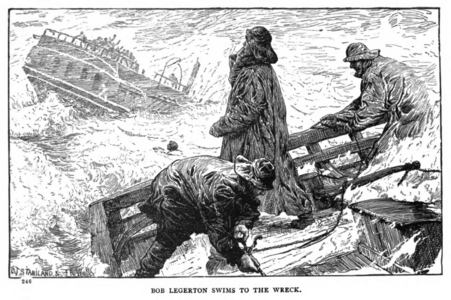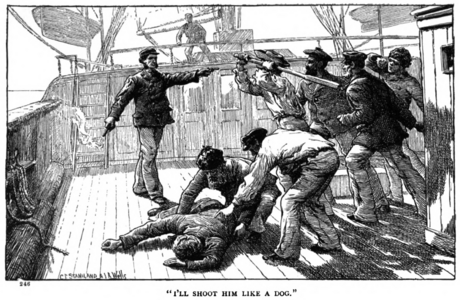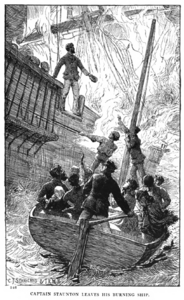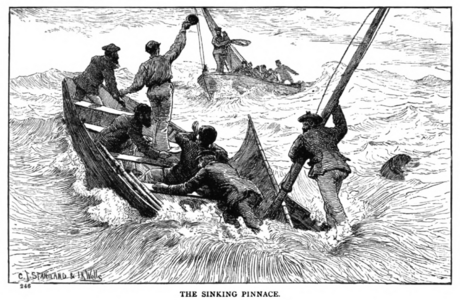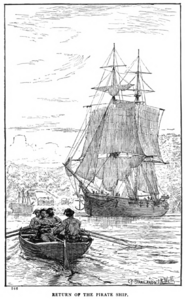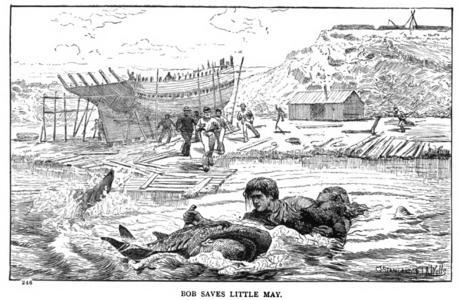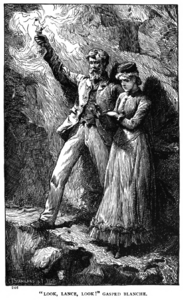Harry Collingwood facts for kids
Quick facts for kids
Harry Collingwood
|
|
|---|---|
| Born | 23 May 1843 Weymouth, Dorset
|
| Died | 10 June 1922 (aged 79) Chester
|
| Nationality | British |
| Other names | William Joseph Cosens Lancaster |
| Occupation | Civil enginineer and novelist |
| Years active | 1860–1922 |
| Known for | Writing boys' adventure stories |
|
Notable work
|
The Pirate Island |
Harry Collingwood was the pen name of William Joseph Cosens Lancaster (born May 23, 1843 – died June 10, 1922). He was a British civil engineer who also wrote many exciting adventure books for boys. Most of his more than 40 books were set on the sea.
Contents
Early Life and Adventures
William Joseph Cosens Lancaster was born in Weymouth, Dorset, England, on May 23, 1843. He was the oldest of three children.
Many sources say he went to the Royal Naval College in Greenwich. However, he likely attended the Royal Naval School nearby. This school trained young men for careers in the Royal Navy and the Merchant Marine.
At age 15, Collingwood joined the Royal Navy as a midshipman. But he had very poor eyesight (he was severely nearsighted). This meant he couldn't continue his dream career at sea. Even though his naval career was short, he traveled a lot during his life. These travels later helped him write realistic adventure stories.
Life as an Engineer
In September 1860, when he was 17, Collingwood started working as an architecture student in Dorset. He then moved to Durban, South Africa, in 1864. There, he worked in different engineering jobs. By 1870, he was the Government Engineer and Surveyor for the Port District of Natal.
He came back to the UK in 1871. He worked on a railway section between Devon and London. He also worked on harbour projects in the Isle of Man. In 1888, he spent a year in Trinidad, surveying for a deep-water port and a railway. He also traveled to the Baltic Sea, the Mediterranean Sea, and the East Indies. His many travels gave him great ideas for the exciting backgrounds in his books.
In 1889, he became an associate member of the Institution of Civil Engineers. This showed he was a skilled engineer, even if he didn't have a university degree in engineering.
Family Life
On July 10, 1878, Collingwood married Kezia Hannah Rice Oxley. She was a draper's assistant, just like his own sisters. Kezia's family was quite large. One of her brothers, Sir Alfred James Rice-Oxley, became a doctor for the Royal Family!
Collingwood and Kezia had one son, William Arthur Percy Lancaster (born 1880). He was usually called Percival Lancaster. Following his father's path, Percival also became a Civil Engineer and a novelist.
Collingwood passed away suddenly on June 10, 1922, at his sister's house in Chester.
Writing Adventure Stories
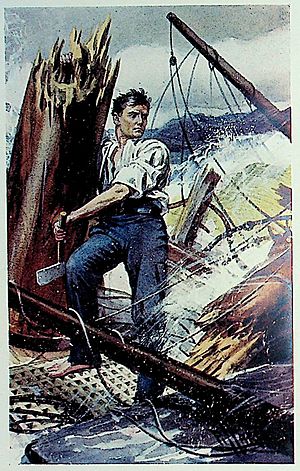
Collingwood's first novel was The Secret of the Sands in 1878. It was a sea tale filled with piracy and buried treasure. He chose the name "Harry Collingwood" as his pen name. He picked this name to honor Vice-Admiral Cuthbert Collingwood, a famous British naval hero.
In his first book, Collingwood said he wanted to mix "a little information with, I hope, a great deal of interest and amusement." He wanted his books to be fun and maybe teach young sailors something useful. People at the time thought he was an excellent storyteller, especially when it came to sea stories. Reviewers said he knew how to tell a story and that his descriptions of sea adventures were amazing.
Collingwood's books were very popular and stayed in print for a long time. Even in the 1920s and 1930s, his adventure stories were still being re-issued. He was considered one of the top writers for boys.
Most of Collingwood's books are sea stories about young English heroes. Unlike some other authors, his heroes usually come from the Merchant Navy or Royal Navy. His engineering background sometimes showed up in his novels. For example, heroes in some of his books were engineers or managers of engineering companies.
Collingwood's novels often featured exciting themes like:
- Storms at sea
- Shipwreck and being castaway on an island
- Piracy and slavery
- Buried treasure
- Long journeys in small boats
- Disasters at sea
- Pearl fishing
He was also good at swimming, rifle-shooting, and horse-riding. These skills often appeared in his heroes. Collingwood loved yachting and designing boats. So, designing small boats to escape from isolated islands was a common idea in his stories.
Three of his books were even science fiction, featuring a flying submarine!
Sample Illustrations from a Collingwood Book
These pictures are from The Pirate Island, a story of the South Pacific (1884). They show common themes in Collingwood's books: bravery, swimming, mutiny, fires at sea, pirates, treasure, and fighting sharks.
Historical Settings in His Books
Collingwood often set his novels during real historical events. However, he would change facts to make the story more exciting. Here are some examples:
- Some novels are set during the Anglo-Spanish War (1585–1604) in the late 1500s.
- Four books deal with the West Africa Squadron trying to stop the Atlantic Slave Trade.
- Under the Chilian Flag (1909) takes place during the War of the Pacific (1879-1884).
- Under the Ensign of the Rising Sun is set during the Russo-Japanese War (1904–1908).
- A Chinese Command (1915) is set against the First Sino-Japanese War (1894–1895).
- Under the Meteor Flag (1884) is set during the French Revolutionary Wars.
- Blue and Grey is set during the American Civil War.
- The Cruise of the 'Thetis' (1910) is set during the Cuban War of Independence (1895–1998).
Books with His Son
Collingwood also wrote one published book with his son, Percival. It was called In the Power of the Enemy (1925). It was first published as a story in a magazine in 1912.
Percival also wrote two books on his own: Captain Jack O'Hara R.N. (1908) and Chaloner of the Bengal Cavalry: a Tale of the Indian Mutiny (1915).
List of Works
You can find a full list of Harry Collingwood's books at Works by Harry Collingwood.


